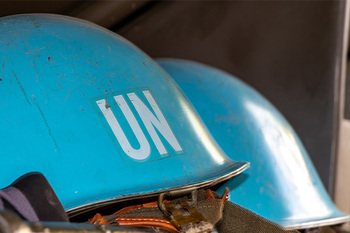In 1939, the outbreak of World War II directly led to the dissolution of the League of Nations. By 1941, American President Franklin D. Roosevelt and British Prime Minister Winston Churchill were already conceiving of the League’s replacement. They envisioned a global alliance led by, as Roosevelt called them, “the Four Policemen”—the United States, the United Kingdom, the Soviet Union, and China—the chief members of the Allied forces in the War. This idea evolved as the war raged on, but in June 1945—just over a month after Victory in Europe Day—the United Nations (UN) Charter was signed. The Charter took effect in October 1945—just over a month after Japan’s formal surrender on the deck of the USS Missouri, finally bringing the War to an end.
The UN was originally made up of six principal organs:
-
The General Assembly
-
The Secretariat
-
International Court of Justice
-
Economic and Social Council
-
Trusteeship Council (inactive)
-
The Security Council
Each of these six had very clearly defined roles. The Trusteeship Council, for example, was designed to manage territorial colonies held by UN member states. When Palau became independent in 1994, the council went into hibernation.
The Role of the United Nations Security Council
To quote the UN, “the Security Council has primary responsibility for the maintenance of international peace and security.” This includes identifying potential threats to peace or aggressive acts and calling on involved parties to find peaceful settlements. In escalatory cases, the Security Council may “resort to imposing sanctions or even authorize the use of force to maintain or restore” peace and security.
Sanctions
The Security Council is authorized to impose mandatory sanctions: diplomatic actions of member states against states, organizations, or persons suspected of violating international law. These sanctions are designed to pressure those who are sanctioned back into compliance.
At the time of this writing, there are 14 sanctions regiments. You can read more in the Security Council’s monthly fact sheet.
Security Council Membership, Leadership, and Controversy
The Security Council is made up of 15 members states. This includes 5 permanent members: France and the Four Policemen—until the Russian Federation was recognized as the Soviet Union’s legal successor in 1991. Together, they are known as the P5.
The remaining 10 seats are held by elected representatives of their respective region for two-year terms:
-
African States hold 3 seats
-
Asia-Pacific States hold 2 seats plus China
-
Eastern European States hold 1 seat plus Russia.
-
Latin America and the Caribbean States hold 2 seats
-
The Western Europe and Other States category holds 2 seats plus the U.S., the U.K., and France.
Veto Power

The UN Charter requires all substantive matters the Security Council proposes to pass on a three-fifths majority (I.E., 9 of the 15 must agree). However, the 5 permanent members hold veto power, which can strike down an otherwise approved proposal.
The inclusion of the veto has occasionally proven controversial. For example, in 1946, France (another permanent member) held colonies in Syria and Lebanon. The Security Council was prepared to vote on the withdrawal of French forces from these colonies, until Soviet diplomat Andrei Vishinsky vetoed it. This established a precedent of the permanent members vetoing resolutions outside their immediate concerns.
Some critics have pointed to the increasing use of the veto as an indication of the Council’s decline in effectiveness and functionality.
Presidency
While the use of the veto has proven controversial, so has the Council’s presidency.
In February 2022, the Russian Federation—in violation of the UN Charter—invaded Ukraine. However, in April 2023, Russia held the Security Council’s presidency. This prompted anger and calls for walkouts among the other 14 members, but, ultimately, such calls were overly reactionary. The presidency only lasts one month, and the role holds little power beyond setting agendas and presiding over meetings. Any Presidential Statements must be approved by the other members.
At the end of April, as is custom, the presidency moved onto the next member in English alphabetical order. In May 2023, this was Switzerland.
The United Nations Security Council’s Future
The discourse around the Security Council—and the United Nations as whole—often focuses on the question of “has it failed?” If it hasn’t failed, what should it do better?
If it has failed, why?
Noting the Council’s membership hasn’t expanded since 1965, does it reflect an evolving geopolitical climate? Should there be more permanent members to better represent the Global South? Should the European Union be considered a member of the P5 rather than France?
Has Russia abused its veto power? Since 1991, Russia has vetoed 32 Security Council resolutions—combined, the other 4 with this power have used it twice more in the same period (the U.S. has used 18; China, 16). This included two vetoes to condemn Russia’s invasion of Ukraine—leading to futile calls to remove Russia from the Security Council. Futile because such action would require unanimous agreement from the P5: in effect, it would require Russia to vote themselves out of the Security Council.
What does the future hold for the Security Council? Though the organ is flawed, studies have shown that it is mostly effective as a crisis management and peacekeeping body.
To explore the deeper questions of the Security Council and of International Security broadly conceived, study at the Notre Dame International Security Center. At NDISC, we gather elite thinkers to investigate the most pressing questions in global security and international relations. To learn more about NDISC and our events, sign up for our newsletter and learn what it means to be a practitioner of foreign policy in all its complexities.
Originally published by at ndisc.nd.edu on April 13, 2023.